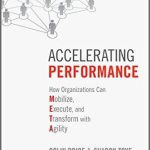The following is adapted from the authors’ new book, Accelerating Performance: How Organizations Can Mobilize, Execute, and Transform with Agility
Savvy HR leaders know that high-functioning teams are the engines of performance in organizations. Yet teams that are able to truly accelerate their performance and maintain it are rare; most teams are bedeviled by challenges that include competing agendas, distorted decision making, and a lack of focus. Indeed, our new research finds that only 13% of the 3,000 teams we studied were classified as top performers (accelerating). Fully 27% were lagging or outright derailing.
 How then can HR executives ensure their organizations get more from their teams? Start by avoiding the factors that our research finds hamper a team’s ability to accelerate performance, which we define as reducing the time to value by building and changing momentum more quickly than competitors.
How then can HR executives ensure their organizations get more from their teams? Start by avoiding the factors that our research finds hamper a team’s ability to accelerate performance, which we define as reducing the time to value by building and changing momentum more quickly than competitors.
By avoiding the following bad habits and turning drag factors into drive factors, teams can improve their performance and add more value to the organization. How much more? Our research found that accelerating teams had an economic impact that was 22.8% higher than that of derailing teams.
Failure to mobilize
Lagging teams fail to inspire or align team members around a compelling purpose or clear priorities. They lack a common understanding of the expectations of stakeholders — a clear and unique commission that might otherwise help them spot and dismantle roadblocks. Struggling teams also tend to focus on themselves. By contrast, accelerating teams focus on customers at all costs. For example, Thyagi Thyagarajan, an independent director at Tata Consultancy Services, says TCS employees “have no fear of being fired by the company. There’s fear of being fired or rejected by the customer.” Accelerating teams hold this attitude.
Poor execution
Teams that execute well have a tight composition and fit-for-purpose structure, with team members moving fluidly into — and out of — roles as needs and skills dictate. Lagging teams, meanwhile, make excuses when it comes to addressing poor performers, and often operate in a fog of unclear accountabilities. They frequently struggle to speak truth to power. Adam Grant writes in his book Originals: How Non-Conformists Move the World that out of almost 1,000 scientists at the U.S. Food and Drug Administration, more than 40% feared retaliation if they raised safety concerns publicly. Such attitudes are common among lagging or derailing teams.
Inability to transform
Competition isn’t a steady-state phenomenon. Successful teams are able to transform both the organizations they lead and how they lead them. They do this by developing the ability to focus outwardly (to leverage stakeholder relationships) and inwardly (to build the trust and candor necessary for robust challenge). Low-performing teams do both of these poorly. One sign of a team struggling to transform is when certain members always dominate conversations, thus distorting the decision-making process. The best teams establish practices to avoid this, such as by creating devil’s advocate roles that rotate among team members.
Lack of agility
Teams that lack agility tend to create ecosystems characterized by inflexibility, a reliance on hindsight, and a victim mentality. These teams are quick to highlight the negatives, and slow to learn from mistakes. By contrast, accelerating teams practice the art of foresight and eagerly scan the environment for signs of change. They are willing to fail fast, adhering to disciplines such as the one articulated by Wharton’s George Day, whose “real, win, worth it” framework pushes managers to repeatedly ask themselves, “Is the opportunity still real?” “Can we still win?” and “Is it worth doing in terms of the expected return?” Such frameworks encourage team leaders to challenge thinking, track performance, and establish triggers that help them to pull the plug on failing efforts fast.
